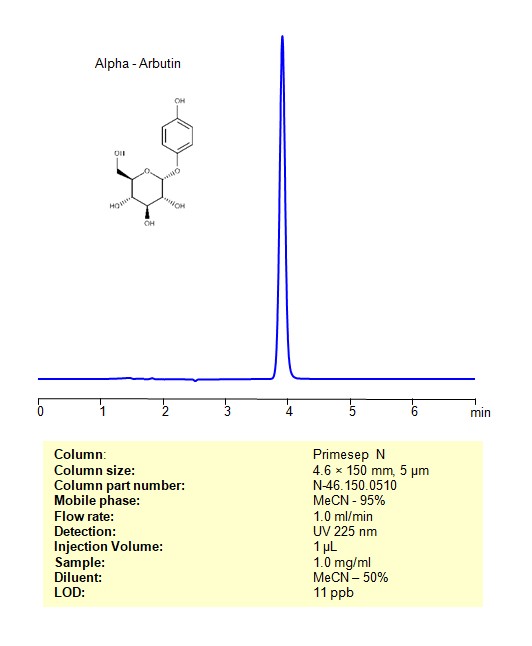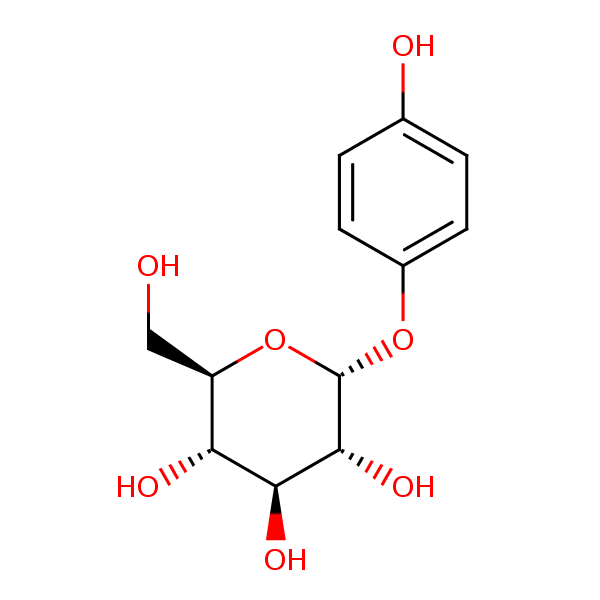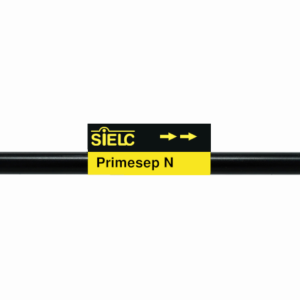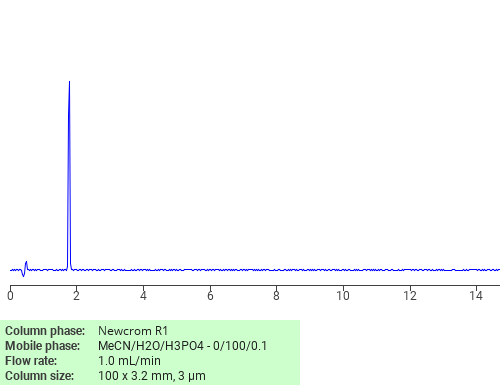| CAS Number | 84380-01-8 |
|---|---|
| Molecular Formula | C12H16O7 |
| Molecular Weight | 272.252 |
| InChI Key | BJRNKVDFDLYUGJ-ZIQFBCGOSA-N |
| LogP | -1.29 |
| Synonyms |
|
Applications:
UV-Vis Spectrum of α-Arbutin
July 15, 2024
For optimal results in HPLC analysis, it is recommended to measure absorbance at a wavelength that matches the absorption maximum of the compound(s) being analyzed. The UV spectrum shown can assist in selecting an appropriate wavelength for your analysis. Please note that certain mobile phases and buffers may block wavelengths below 230 nm, rendering absorbance measurement at these wavelengths ineffective. If detection below 230 nm is required, it is recommended to use acetonitrile and water as low UV-transparent mobile phases, with phosphoric acid and its salts, sulfuric acid, and TFA as buffers.

HPLC Method for Analysis of Alpha – Arbutin on Primesep N Column
February 16, 2024
HPLC MS Method for Analysis of alpha-Arbutin on Primesep N Column
Separation type: Liquid Chromatography Mixed-mode SIELC Technologies

High Performance Liquid Chromatography (HPLC) Method for Analysis of alpha-Arbutin
Alpha-arbutin is a naturally occurring compound found in certain plants, particularly in the bearberry (Arctostaphylos uva-ursi) plant, cranberries, blueberries, and pears. It is a glycoside derivative of hydroquinone, which means it has a glucose molecule attached to a hydroquinone molecule.
Skin Lightening: Alpha-arbutin is known for its skin-lightening properties. It is often used in skincare products to reduce the appearance of hyperpigmentation, such as dark spots and age spots.
Inhibition of Tyrosinase: Alpha-arbutin works by inhibiting the activity of the enzyme tyrosinase, which is involved in the production of melanin (the pigment responsible for skin color). By inhibiting tyrosinase, alpha-arbutin helps to reduce melanin production and, consequently, lighten the skin.
Cosmetic Products: Alpha-arbutin is commonly used as an ingredient in various skincare and cosmetic products, such as creams, serums, and lotions, aimed at promoting even skin tone and reducing the appearance of dark spots.
It’s essential to note that while alpha-arbutin is generally considered safe for topical use, individuals with sensitive skin or those undergoing specific skincare treatments should consult with a dermatologist or healthcare professional before using products containing this ingredient.
Alpha – Arbutin can be retained and analyzed using a Primesep N mixed-mode stationary phase column. The analysis employs an isocratic method with a simple mobile phase comprising water, acetonitrile (MeCN). This method allows for detection using UV at 225 nm
| Column | Primesep N, 4.6 x 150 mm, 5 µm, 100 A, dual ended |
| Mobile Phase | MeCN 95% |
| Buffer | None |
| Flow Rate | 0.2 ml/min |
| Detection | UV 225nm |
| Samples | 1 mg/ml |
| Injection volume | 1 µl |
| LOD* | 11 ppb |
| Class of Compounds | Antiarrhythmic agent, Amide |
| Analyzing Compounds | alpha-Arbutin |
Application Column
Primesep N
Column Diameter: 4.6 mm
Column Length: 150 mm
Particle Size: 5 µm
Pore Size: 100 A
Column options: dual ended

Separation of alpha-Arbutin on Newcrom R1 HPLC column
May 16, 2018
alpha-Arbutin can be analyzed by this reverse phase (RP) HPLC method with simple conditions. The mobile phase contains an acetonitrile (MeCN), water, and phosphoric acid. For Mass-Spec (MS) compatible applications the phosphoric acid needs to be replaced with formic acid. Smaller 3 µm particles columns available for fast UPLC applications. This liquid chromatography method is scalable and can be used for isolation impurities in preparative separation. It also suitable for pharmacokinetics.
Application Column
Newcrom R1
The Newcrom columns are a family of reverse-phase-based columns. Newcrom A, AH, B, and BH are all mixed-mode columns with either positive or negative ion-pairing groups attached to either short (25 Å) or long (100 Å) ligand chains. Newcrom R1 is a special reverse-phase column with low silanol activity.
Select options



